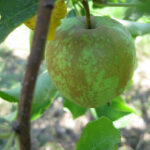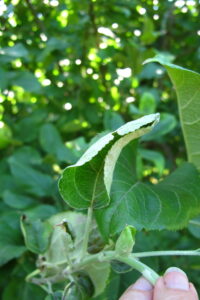Currently, the US Drought Monitor (https://droughtmonitor.unl.edu/CurrentMap/StateDroughtMonitor.aspx?IN) places Indiana in the ‘abnormally dry’ category. With no rain in our 10 day forecast, I expect that to only get worse, and with it, powdery mildew on all fruit crops.
Powdery mildew is identified by the white, powdery growth on leaves and shoots that consist of the fungal body and spores (Fig. 1). Leaves infected along the leaf margin may become curled, crinkled, or folded along the midrib. On apples, if you are fortunate enough to have them this year, fruit is often russetted (Fig. 2).
- Figure 1. Powdery mildew on leaves may be difficult to identify, particularly on those “hairy” leaved (tomentose) cultivars!
- Figure 2. Powdery mildew causes russetting on developing apples. Photo by Janna Beckerman.
The hot, dry weather has set the stage for a severe powdery mildew outbreak, which will first appear in southern Indiana, and continuing to show up in the northern part of the state in late June early July. Disease development is favored by hot days and cool, moist nights with the disease most severe when hot, dry summers follow mild winters, like the winter of 2023. Leaves are most susceptible to infection in the first few days after they open, particularly on highly susceptible cultivars like Cortland, Jonathan, Gala, Ginger Gold, Granny Smith, Ida Red, Stayman Winesap and Rome. Honeycrisp is also showing symptoms of infection at Meigs (Fig. 3). Our wet spring in much of the state may have reduced that initial inoculum level, but recent dry weather has allowed PM to get a foothold. Keep an eye on the terminals of susceptible varieties, especially Jonathan, which is one of the most PM-susceptible varieties.
One of the biggest problems in managing powdery mildew is our unfamiliarity with it. Growers know to fear wet weather, and the diseases that coincide with it, and usually stay on top of spray programs. Dry weather is often viewed as an opportunity to save money on the costs of pesticides, particularly in a year in which many growers do not have a crop. Powdery mildew serves as both an example and warning of what happens when disease management practices lapse and reminds us that pesticides residues are reduced by photodegradation, normal chemical decomposition and simple leaf growth, not only rain wash-off.
Chemical control of powdery mildew is usually done with controls for scab, and fungicides are almost always necessary to control the disease when powdery mildew-susceptible varieties are grown under susceptible conditions. DMI fungicides like Rally, Avelyo and Topguard have been repeatedly shown to provide better control of powdery mildew than Indar and Inspire. During a normal growing year (what is that, exactly?), the application should be timed at tight cluster to pink and continuing at 7-10 day intervals until terminal buds have set and shoots are no longer producing new leaves that are susceptible to infection.
Why is this important right now? Right now, buds are forming, particularly on younger trees, and these buds may become infected with powdery mildew. Disease occurring now will increase the percentage of infected buds, resulting in increased levels of primary inoculum next spring. If the drought continues (as predicted) and the disease is particularly severe, it will reduce flower bud formation, with the potential to reduce or eliminate the crop next year. Recall that the severity of this may be reduced if temperatures dip below -20 degrees C during the winter, not a common occurrence in Indiana. But then again, neither is powdery mildew of apple.
To spray or not to spray? As we enter mid-season (3 to 9 weeks post-bloom), monitor secondary infection by determining the percent of leaves with infection on ten terminal shoots on each sample tree. Keep in mind that you may not easily see PM infection and could overlook symptomatic leaf curling caused by PM (Fig 3). Twenty percent leaf infection indicates a weakness in the control program, a high level of risk for fruit and bud infection, and a recurrent problem with chronic yield reductions in subsequent years. Despite using captan for summer rot control, it is important to remember that captan provides no control against powdery mildew! FRAC 11 (or 7+11) have not been found to be as effective on PM as the FRAC 3 chemistry, so reliance on a typical summer cover schedule may leave you exposed to PM outbreaks.


